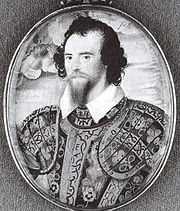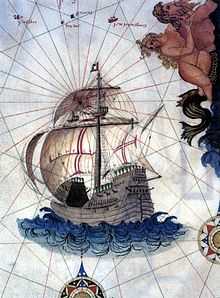Action of Faial
The Action of Faial or the Battle of Faial Island was a naval engagement that took place on 22 - 23 of June 1594 during the Anglo-Spanish War in which the large and rich 2,000 ton Portuguese carrack Cinco Chagas was destroyed by an English fleet after a long and bitter battle off Faial Island in the Azores. The carrack, which was reputedly one of the richest to set sail from the Indies, was lost in an explosion which denied the English as well as the Portuguese and Spanish, the riches.[1][5]
Background
By virtue of the Iberian Union, the Anglo-Portuguese Treaty of 1373 was in abeyance, and as the Anglo–Spanish War was still ongoing, Portuguese shipping was a fair target for the English navy and privateers.[1] In the latter end of 1593 and hoping to capitalize on the success of the capture of the Madre de Deus; the Earl of Cumberland, at his own expense prepared three ships of 250 to 300 tons, with at total of 420 sailors and soldiers with two artillery decks each.[2][6] The Royal Exchange owned by London Merchants, William Holliday, Thomas Cordell and William Garraway where George Cave was captain.[6] The Mayflower - Vice Admiral under the conduct of William Anthony, the Sampson, under Nicholas Downton and a support pinnace Violet.[7]:128[8]

On 6 April 1594 they set sail from Plymouth, heading towards the coast of Spain. As they headed towards the Azores they roamed the coast of Portugal and Spain capturing a number of ships. Off Viana do Castelo, Portugal, a 28 tonne barque was captured as it headed towards Portuguese Angola. Near the islands of Berlengas another three Portuguese and Spanish caravels, were taken one of which had twelve butts of Spanish wine and another with a small chest of silver.[8] They were then sent back to England under prize crews guarded by the Violet while the rest of the fleet headed towards the Azores. They were also hoping to avoid Alonso de Bazán's Spanish fleet which was on the lookout for Cumberland after his failure attempting to intercept him two years earlier.[7]:130
On the 22 of June 1594, as they approached Faial island, Mayflower soon saw a great sail approach them and realized this was a huge Portuguese carrack.[4]
The carrack was the Cinco Chagas (Five wounds) and was a thirty two gun 2000 ton carrack which had departed from Goa heading for Portugal in 1593, under the command of Francisco de Mello, one of the "greatest naus that ever were in the Carreira, loaded with great wealthness and precious stones and all the best of India".[3] Constructed in Goa by the Viceroy Dom Constantino de Braganza in 1559-60, she had made ten voyages being the flagship of five viceroys.[5]
The rest of the fleet consisted of the carracks Santo Alberto, and Nossa Senhora da Nazareth. Both the Santo Alberto and Nazareth sprung fatal leaks and were beached in on Mozambique's coast. The Cinco Chagas took all the cargo in diamonds and other precious gems from the two lost carracks as well the 400 passengers and crew members, of which 230 were slaves.[9]:45 There were also two VIPs Nuno Velho Pereira the former governor of Portuguese Mozambique and Dom Braz Correia the captain of the fleet heading from the Indies.[2] Having stopped by Luanda, in Portuguese Angola, for supplies, where they took more slaves which were in fact, more mouths to feed. By the time it reached the Azores disease had taken nearly half the complement many of which were women and children and most of the food provisions were thrown overboard.[9]:47 As they passed the channel heading towards Faial, the lookouts on Chagas spotted the English ship and soon prepared for battle.[8]
Battle

At noon all four ships exchanged broadsides and musket volleys in a battle that lasted for nearly a whole day. The English ships tried to board the Cinco Chagas but were repelled by the larger Portuguese numbers. As casualties mounted on both sides the decks of the carrack were cluttered with dead and wounded.[3]
The battle went on with the English trying to board the ship three times. All three attempts however were repelled by the Portuguese - putting up a brave fight knowing the riches were too great to lose. The captain of the Mayflower George Cave was killed which discouraged his men from attacking.[2] The crew of Sampson was repulsed with losses and fighting continued for several hours with the four ships moored to each other.[4] Shortly after, the other two ships, having lost hope of mastering Chagas drifted off and Nicholas Downton was severely wounded and William Antony later was mortally wounded.[8]
However on having noticed that Cinco Chagas had no guns aft, in a deft maneuver the English returned to the attack concentrating their fire on the stern panel of Portuguese ship.[4] The Royal Exchange made another boarding attack this time succeeding in carrying the ship after bitter fighting. Whilst heavy hand to hand fighting was ongoing a fire had started on a tarpaulin during the exchange of fire and then spread further to the rigging and the masts.[7]:132 The fire could not be put out because sharpshooters on board the English ships were taking the Portuguese one by one as they tried to man the pumps.[3]
According to the only eyewitness account available, written by Melchior Estácio do Amaral in 1604:
the sea was purple with blood dripping from the scuppers, the decks cluttered with the dead and the fire raging in some parts of the ships, and the air so filled with smoke that, not only we could sometimes not see each other but we could not recognize each other.[9]:52
Seeing the fire out of control and with the English gaining the upper hand, the Portuguese decided to abandon ship grabbing anything that could float.[9]:53 At the same the English came on aboard with some armed boats. However the fire was now out of control and so the decision by Cumberland to evacuate was given. The carrack burned all through the night and when the flames reached sixty barrels of powder in her hold on the morning of the 15th she blew up.[1] The explosion was enormous killing hundreds of Portuguese which included men, women and children, nearly 35 English were on board still when the ship blew up. Most were killed outright and the battle ended with the destruction of the ship.[8]
Aftermath
The crew grabbed any floating remains that were of any value which proved to be little and then set off picking up any survivors of which there only thirteen out of 600 Portuguese.[7]:134 They sailed further West in the hope of any rich pickings and soon encountered another carrack the San Fellipe two weeks later.[6] With heavy losses already in disease and with officers wounded or killed, supplies running low and a gale forcing them apart Cumberland decided against and sailed home.[8]
The cargo of Cinco Chagas (along with the salvaged cargo from the two other carracks) was worth well in excess of 2,000,000 ducats, plus twenty two treasure chests of diamonds, rubies and pearls estimated to be worth well over 1 billion in today's dollars.[5] The prisoners that were saved told their captors that yielding was impossible as the riches were for the king of Spain and Portugal and that the captain being highly in favor of him on his return home would have been made viceroy in the Indies.[3][9]:56
With the destruction of the Chagas Cumberland had to satisfy himself in the fact that the Portuguese and Spanish were denied any of the riches on board.[3] He successfully evaded any attempt by the Spanish navy to find him.[4] Alonso de Bazán again failed to intercept Cumberland partly because he was hoping to protect the West Indian treasure fleet which was still in the Caribbean.[9]:57 Another fleet under Don Antonio De Urquiola also failed to find the English despite being in the same area when they headed home past Cape St. Vincent in September.[8]
The fleet arrived in Portsmouth on the 28th of August and the ships were thoroughly searched when they arrived by the Queens troops; a consequence of the mass theft of the Madre de Deus two years earlier. Dom Nuno Velho Pereira and Dom Braz Correia survived the explosion and were brought ashore as prisoners where the earl treated them well and entertained them a whole year as his guests. They were then ransomed for 2500 ducats each which Pereira paid for both making Cumberland's 1594 expedition gain at least some value.[2][7]:132 The Earl with this money then decided to finance and build a new larger ship rather borrowing from the Queen; the new ship was launched in 1595 and named by the Queen as the Scourge of Malice.[10]
Legacy
According to the Venetian ambassador to Spain, it was the richest ship ever to sail from the East Indies.[7]:136
Estimates of the Cinco Chagas's location suggest that it lies in seas over one mile deep in the Atlantic ocean eighteen miles south of the channel between Pico Island and Faial along with its precious cargo of diamonds and gems.[5] The wreck has been searched for by treasure hunters but no signs have been found partly due to the depth.[11]
Notes
- ↑ 1.0 1.1 1.2 1.3 Andrews pg. 219
- ↑ 2.0 2.1 2.2 2.3 2.4 Lediard & de Puisieux pg. 644–47
- ↑ 3.0 3.1 3.2 3.3 3.4 3.5 Hakluyt, Richard (2002) [1598]. The Principal Navigations, Voyages, Traffiques and Discoveries of the English Nation. p. 571.
- ↑ 4.0 4.1 4.2 4.3 4.4 Southey 28–33
- ↑ 5.0 5.1 5.2 5.3 Horner pg. 229
- ↑ 6.0 6.1 6.2 Andrews pg. 76
- ↑ 7.0 7.1 7.2 7.3 7.4 7.5 Williamson 126–37
- ↑ 8.0 8.1 8.2 8.3 8.4 8.5 8.6 Oppenheim 310–11
- ↑ 9.0 9.1 9.2 9.3 9.4 9.5 Amaral pg. 45–57
- ↑ Nichols (1823), pp 496–497.
- ↑ "Still Sunk: The Last Great Mystery Wrecks of the Ocean Floor". Gizmodo. Retrieved 7 November 2013.
References
- Amaral, Melchior Estacio Do (2010). Tratado das batalhas e sucessos do Galeão Sanctiago com os Olandeses na Ilha de Sancta Elena: e da náo Chagas com os Vngleses antre as Ilhas dos A¸ores. Nabu Press. ISBN 978-1149563519. (Portuguese)
- Andrews, Kenneth R. (3 Jan 1964). Elizabethan Privateering 1583-1603. Cambridge: Cambridge University Press. pp. 180–81. ISBN 9780521040327.
- Guérin & Köller (Apr–June 2009). Of Shipwrecks, Lost Worlds and Grave Robbers, A World of Sci. A World of Sci. Check date values in:
|date=(help) - Horner, Dave (1971). The Treasure Galleons: Clues to Millions in Sunken Gold and Silver. Dodd, Mead - University of Texas. ISBN 9780396063780.
- Oppenheim, M. (2010). The Naval Tracts Of Sir William Monson by William Monson. Kessinger. ISBN 978-1163120194.
- Southey, Robert (2010). Lives of the British Admirals: With an Introductory View of the Naval History of England, Volume 3. Longman, 1834.
- Williamson, Dr. G. C. (1920). George, third earl of Cumberland (1558-1605) his life and his voyages. University Press, Cambridge. ISBN 978-0217481441.